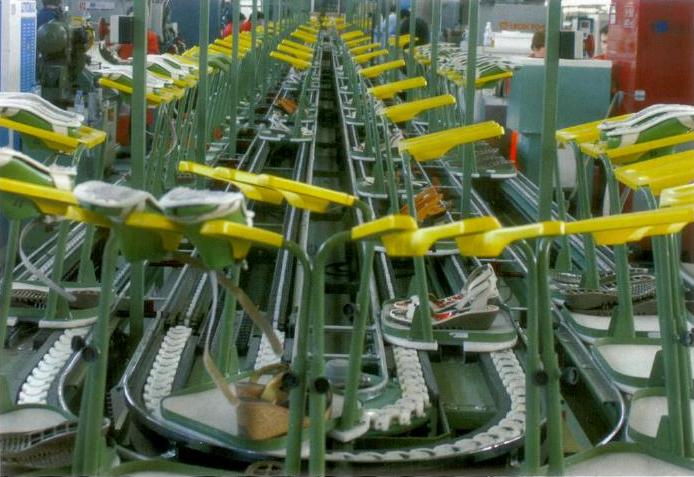- Menu

When INESC Porto, a research organisation with a broad range of interests, decided to make a contribution to the CEC Made Shoe project, it made the wise choice of asking a prominent Portuguese footwear company to work with it. So, with the help of Kyaia (whose Fly London brand is well known internationally), and of automated systems provider Lirel, it embraced the task of making footwear production more efficient.
Project leader, senior INESC technician Rui Rebelo, explains: “Some years ago, we noted that shoe production systems often became very inefficient. Also, it seemed to us that the systems most manufacturers had in place were not equipped to make small production lots viable, or to offer companies the possibility of producing shoes of more than one construction. We thought it was time to come up with a new way.”
To be able to offer flexibility and speed are among the greatest challenges facing footwear manufacturers in today’s though, global marketplace. Even big buyers are placing smaller orders and demanding shorter order cycle times to tie up less cash in stock and to try to react faster to changing consumer demand. It was in this context that the Portuguese project team examined the possibility of a system that would allow manufacturers to “produce a shoe in just one place”, with all parts of the process taking place one phase.
The result is a new automated system, 33 metres long and 2 metres wide, controlled by a new software application, which links to RIDF tags on pallets so that the system can capture quickly and easily all the details of any particular production lot. The configuration that has already gone into a Kyaia factory consists of an outer ring and an inner one, though other variations are possible.
“After about nine months of using the new system, the Kyaia factory was able to increase the construction types of the shoes it was producing from one to four,” Mr Rebelos says, “and productivity increased by around 15%. The stock the manufacturer had to hold also reduced, which has led us to conclude that, from an initial investment of € 100,000, Kyaia will achieve full pay-back in 18 months. That amount of money was enough for 25 work posts and included the software, the conveyor system and the portal reader”.
He accepts that, for companies dealing with large volume orders, it would probably still make more sense “to set up a line and do continuous production”, but if it’s small orders companies have to deal with, he believes the idea born of the CEC Made Shoe project (“one of the best to have come out of the project so far”) could offer good options.
The system aims to keep any hold-ups, periods of downtime or build up of stock to a minimum.
It works by setting up each of the stages of production in sequence, from cutting to final assembly, with shoes moving in a steady flow from one stage to the next on the automated conveyor system, sometimes to an operator, sometimes to a completely automated part of the construction process. But the sequencing of the different activities means a team of workers can produce small lots of different models of footwear simultaneously without any downtime, offering what Mr Rebelo describes as better balance and control in the production line, including the ability to change priorities in the course of a working day if something urgent comes up, such as a customer asking for shipment dates to come forward.
Another important advantage he points to is the ability for companies to identify more quickly, more easily, more objectively and more accurately which aspects of any operation add least value so they can be modified or, possibly, eliminated. All of this can provide footwear manufacturers with valuable assistance in becoming more efficient and more responsive to the needs of their costumers.
“…and it should be noted…”
There have been many attempts at improving the efficiency and output of lasting and making departments over the years. Conveyors ruled the roost for a long while and certainly cut throughput time and raised output. Unfortunately, in too many cases, this was often at the expense of quality. They were essentially aimed at mass production and, as the industry began to change in the 1980’s, the demand for more flexibility in terms of pairage per style led to the Rink system where groups of machines were linked in sequence. This was certainly a step in the right direction, but like the conveyor, was still geared to a single construction.
More recent systems have become highly automated trough the extensive use of robots. Although the can dramatically improve output and consistency of quality while at the same time reducing labour content and cost, and still be extremely flexible in terms of mixing sizes and designs, they are once again single construction systems-usually direct moulded. Until now, nobody has been able to provide flexibility of construction as well as all these other advantages.
Inesc says that its OneStepProductionProcess can accommodate constructions as varied as Stuck-on, Goodyear welted and Strobel all on the one system. Although each construction still needs a different routing and sequence of operations, the system uses its internal ring, external ring and crossovers to create different paths customised for each construction type with minimal intermediate stops and storage throughout the production process. If this is the case, manufacturers can at last mix different styles and lasts in different size ranges and in different constructions, all in one go, and that, has to be good news.
World Footwear, Março/Abril 2009
28th April 2009
The access to the final selection minute is only available to applicants.
Please check the confirmation e-mail of your application to obtain the access code.

